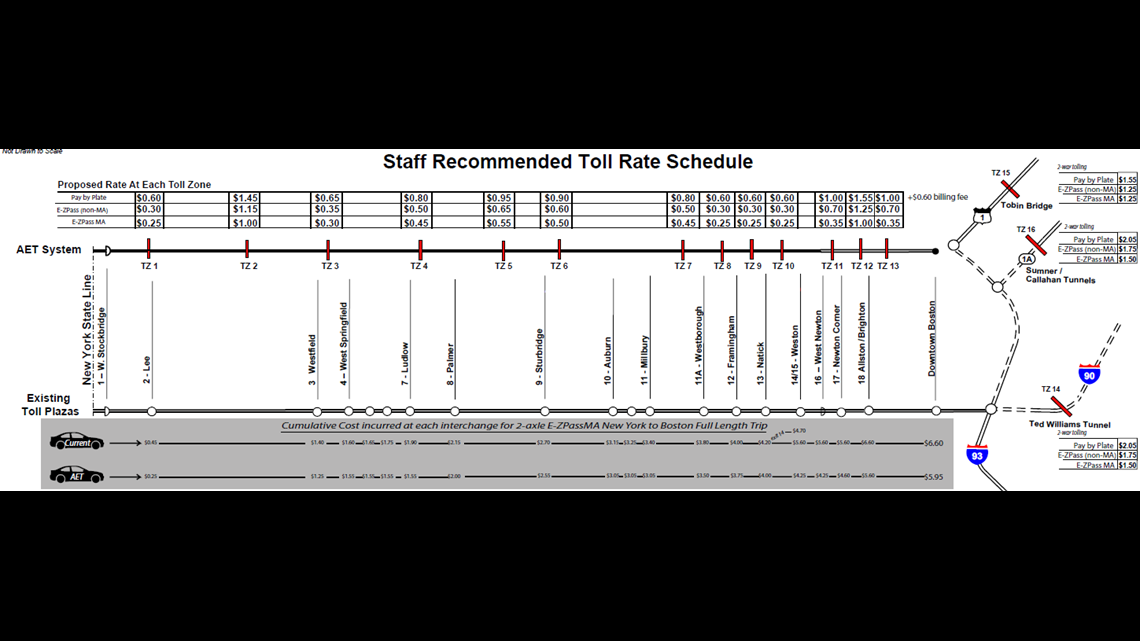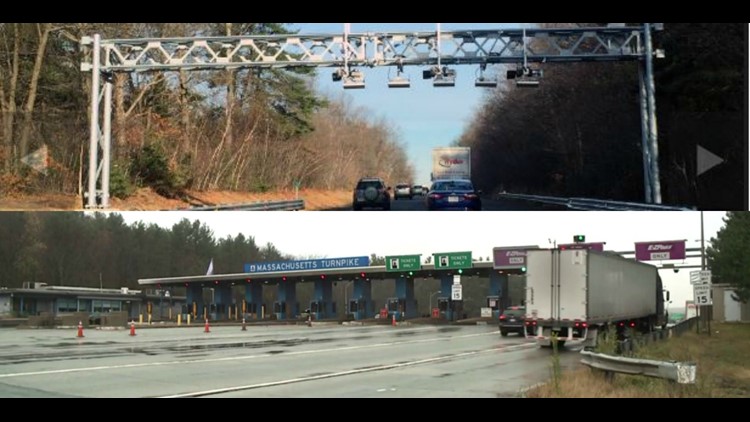HARTFORD - New ticketless tolling starts Friday on the Mass Pike. That means the Sturbridge Toll plaza – and all others - will be torn down. Here is what you can expect, according to the Massachusetts Department of Transportation.
Why is this being implemented?
The primary purposes of electronic tolling are to increase safety, alleviate congestion, and reduce Greenhouse gases. Statistics show that dramatic speed reductions and congestion often occur at toll plazas, which can lead to vehicle crashes. Because electronic tolling allows for constant travel at the speed limit under gantry locations, there will be no more slowdowns on approach to or exit from toll plazas. The crash rate for the Weston toll plaza, for example, is about 60 percent higher than it is on the adjacent mainline roadway. Electronic tolling will also help improve air quality by reducing emissions from vehicles idling in toll lanes or accelerating and decelerating in manual collection toll lanes and existing E-ZPass lanes, where drivers must now reduce their speed to 15 miles per hour.
How does electronic tolling work?
Electronic tolling gantries have been installed at 16 locations on I-90 and are equipped with sensors that will electronically register toll charges as vehicles pass under them. Drivers will no longer have to stop at a toll plaza and will be able to maintain a safe highway speed. If a vehicle has an E-ZPass transponder, the toll will be automatically charged to the E-ZPass account associated with that vehicle. Drivers are not required to use transponders. If a vehicle does not have an E-ZPass transponder, cameras mounted on the gantry will photograph the vehicle’s license plate and the registered owner will be sent an invoice. In addition to the actual gantry charge, customers who do not use an E-ZPass transponder will pay a “Pay-by-Plate” fee to cover mailing, processing, and other costs. E-ZPassMA transponder account holders will be charged less per toll than drivers with no transponder. Drivers who do not have E-ZPass transponders are encouraged to obtain one, free of cost.
How much will it cost?
The cost of tolls will be different at each toll, and will also cost different amounts based on if you have an E-ZPass and which state you live in.
Those who have an E-ZPass from Massachusetts will pay the least, while those with no E-ZPass will pay the most. Also, if you don't have an E-ZPass, you will also be charged a $0.60 billing fee.
Here's the breakdown, or click here to read the full document:


How were gantry locations selected?
Gantry locations were selected based on a 2012 study by AECOM that considered traffic volume, roadway geometry, and other factors. Electronic tolling gantries have been installed at these Massachusetts Turnpike locations: Lee (mile marker 10.01), Blandford (mile marker 26.25), Westfield (mile marker 40.86), Ludlow (mile marker 57.68), Warren (mile marker 69.78), Charlton (mile marker 89.10), Hopkinton (mile marker 104.86), Southborough (mile marker 109.07), Framingham (mile marker 113.92), Weston (mile marker 120.21), Newton (mile marker 126.18), Brighton (mile marker 130.04), and Allston (mile marker 131.15). Gantries have been placed so that tolls will be collected in both directions on the Tobin Bridge and all Boston tunnels. These tolls are revenue neutral. For example, the cost to travel in one direction on the Tobin Bridge before electronic tolling is now half the cost since travel in both directions is now tolled. (The southbound gantry on the Charlestown side of the Tobin Bridge has been operational since July 2014 and an additional gantry has been placed in Charlestown on the northbound side.) On the Sumner/Callahan tunnels, gantries have been added on the East Boston side of the two tunnels. At the Ted Williams Tunnel, Electronic tolling equipment has been placed on existing structures on the South Boston side both eastbound and westbound. Residents who received toll discounts before electronic tolling at the Boston area toll locations will continue to be given discounts after electronic tolling is in effect.
Why do some stretches of the Turnpike (Weston and Hopkinton) have several gantries while other sections (the western portion of the Turnpike) have relatively few gantries? Why are drivers, in Springfield and Worcester after the AET, able to enter and exit the Turnpike without paying a toll?
The original goal was to locate gantries between every turnpike interchange so that all customers would pay. However, an analysis determined that it would not be cost-effective to install gantries between all of the closely spaced interchanges around Springfield and Worcester, where both toll rates and traffic volumes are relatively low. Therefore, due to the placement of some gantries, some drivers will enter and exit I-90 between gantry locations and will not be charged.Why has a gantry been installed at the Newton interchange, which had been un-tolled?
The placement of the electronic tolling gantry between Interchanges 16 and 17 in Newton is intended to discourage I-95/128 cut-through traffic by drivers who attempt to avoid the Weston toll and to increase tolling equity as this section had previously been tolled. Just as passenger vehicle tolls were restored to Exits 1 through 6 on the western part of the Turnpike in 2013, toll collection will be restored to the Newton area with this gantry. Gantry locations were based on a study conducted in 2012.Is MassDOT raising tolls on the Turnpike, tunnels, and Tobin Bridge?
MassDOT is not implementing a toll increase. The goal in setting gantry rates was to remain revenue neutral, maintaining existing revenue collection to be substantially equal to what had been collected prior to electronic tolling. However, individual drivers may see their tolls decrease, stay the same or increase for a given trip from point to point within the Turnpike since tolls will be charged and collected at gantries that vary from current toll locations. This change in the location of toll collections required MassDOT to set the rates that will be charged at each gantry. As part of the effort to keep the tolling changes revenue neutral, electronic tolling rates have been set so that passenger vehicles with E-ZPassMA transponders traveling from the New York border to Boston will pay less after electronic tolling is in effect than they did before. E-ZPassMA customers currently pay $6.60, under electronic tolling they will pay $5.95.
How were gantry rates set?
Gantry rates were developed by calculating the per mile cost of travel on different sections of I-90. Setting rates at each gantry will be as close to that per mile cost of travel today, making adjustments to address issues of toll equity. Total revenue generated on the Western Turnpike and Metropolitan Highway System will remain substantially equal to the total revenue generated by the current toll system. MassDOT held seven public hearings during September 2016 to solicit public input and received comment from the MassDOT Tollpayer Advocate before the new rate structure was finalized by members of the MassDOT Board of Directors on October 6, 2016.What about point-to-point or gantry to gantry charges within the Turnpike?
In 1997, the Massachusetts Legislature split the Massachusetts Turnpike into two “facilities:” the Western Turnpike, from the New York State border to Weston, and the Metropolitan Highway System (MHS), which includes the Turnpike east of Weston, the Central Artery, the Callahan, Sumner, and Ted Williams Tunnels, (the Tobin Bridge was added later to the MHS). Under the law, revenue from each “facility” can only support the operations and debt of the respective “facility”. This was done to insulate Western Turnpike users from paying for the Central Artery (Big Dig) debt. Proposed gantry rates are designed to maintain existing I-90 and MHS revenue levels. But due to the spacing of the gantries, point-to-point toll rates may go up or down. Some trips that are currently un-tolled now will be tolled and vice versa.Will tolls change on the Tobin Bridge?
Currently, passenger vehicles traveling southbound over the Tobin Bridge without an E-ZPass transponder pay $3.00 under the “Pay-by-Plate” system. Passenger vehicles with an E-ZPass transponder pay $2.50. When electronic tolling goes live, the Tobin Bridge will be tolled in both directions, with the toll split equally so that E-ZPassMA customers will pay the same roundtrip amount as today. Qualified residents of Chelsea and Charlestown will continue to be eligible for the Tobin Bridge resident discount program, where $0.15 will be collected in each direction. To qualify for the discount, a vehicle owner must live in zip codes 02129 or 02150.What about tolls to use the Sumner/Callahan/Ted Williams Tunnels?
As with the Tobin Bridge, tolls will be collected in both directions for use of the Sumner, Callahan and Ted Williams tunnels. The fare for E-ZPassMA customers in each direction will be half of what those drivers currently pay for traveling in one direction. The tunnel resident discount program will remain and eligible customers will be charged $0.20 in each direction.Will people pay more if they don’t have a Massachusetts EZPass transponder?
Yes. For each vehicle class, MassDOT has three rates at each gantry:
- One rate is for users of E-ZPass transponders issued by the Commonwealth (E-ZPassMA).
- One rate is for users of compatible transponders issued by other states (residents of other states can obtain EZPassMA transponders if they wish).
- One rate is for vehicles that do not have any transponder and will be billed using the Pay-By-Plate system. This billing will include both the gantry charge and a processing fee to offset mailing and other costs associated with Pay-by-Plate users.
What if I don’t have an EZPass transponder or don’t want one that is linked to a bank account?
MassDOT encourages everyone who will be using the electronic tolling system to obtain an E-ZPassMA transponder, which are free. MassDOT will be distributing transponders in many communities where electronic tolling will be going live. Transponders are also available at Massachusetts Registry of Motor Vehicles Service Centers and at American Automobile Association offices. Further information about where and how to get transponders can be found at the E-ZPass MA web page. An E-ZPassMA account does not need to be linked to a bank account but instead can be replenished with cash for those who do not have bank accounts or would prefer not to link their EZPass account to a bank account.Will people have a chance to comment on these proposed AET tolls and fees?
MassDOT has completed its official public comment period after holding seven public hearings about electronic tolling during September 2016 and receiving comment in the mail and from online submissions. The MassDOT Board voted and approved the final toll rate structure on October 6, 2016. Drivers can use MassDOT’s toll rate calculator to view electronic tolling rates.What kind of personal data will the gantries collect?
By both law and policy, MassDOT is committed to ensuring the privacy of all motorists. All data collected is done so only for billing purposes and will remain secure and kept confidential. Data is collected about license plate, transponder, location, and time. Cameras collect still images and video records axles to assure billing is appropriate for vehicle type. Speed data is used to ensure an accurate image capture of vehicle license plate by cameras. Speed data cannot legally be used for any traffic law enforcement purposes. In order to minimize the risks that electronic tolling data could be accessed for inappropriate uses, MassDOT requires electronic tolling contractors to keep current with all standards for data security, including Payment Card Industry and Personally Identifiable Information standards.Will information collected by AET be used to issue speeding tickets or for other traffic law enforcement?
No. The purpose of electronic tolling is to collect tolls. Data from electronic tolling cameras or auto readers cannot legally be used to issue tickets for speeding or other moving violations in the Commonwealth. MassDOT has no plans to change that, meaning electronic tolling gantries will not be used for moving violation enforcement.Is AET data retained?
Data is collected through the electronic tolling system solely for the purpose of billing so that drivers can be accurately charged. The records and data collected are not public records per statute and will be retained only as necessary to carry out this purpose. MassDOT has received approval from the state’s Records Conservation Bureau for the length of time certain information must be retained for billing purposes. Information not needed for several years will be destroyed sooner. For example, vehicle speed data will be deleted after 30 days.What is the "Hot List" and does MassDOT intend to use it?
The electronic tolling contract signed in 2014 called for a Hot List function, which would provide real-time notification via email to specified email addresses whenever an identified plate or transponder goes through a gantry. MassDOT will not use this Hot List capability for traffic enforcement, such as speeding violations or non-payment of tolls. MassDOT, working with its public safety partners, has defined a narrow set of public safety threats in which the Secretary of the Executive Office of Public Safety could request use of electronic tolling-generated Hot List information in the case of time-sensitive emergencies, such as Amber Alerts. MassDOT has published regulations that define these limited and very specific circumstances for the use of Hot Lists. While projections several years ago said electronic tolling would save about $50 million a year in operating costs, that estimate did not include initial capital costs and also did not fully account for operating costs for the new electronic tolling system. Electronic tolling will reduce toll collection operating costs by about $5 million annually but some operating expenses will increase, such as the costs of processing and mailing bills to Pay-by-Plate users. As MassDOT continues to improve collection and other practices, net toll revenues may rise further. In addition to operating costs, capital costs have been incurred to build the electronic tolling system and will be incurred to demolish the toll plazas and reconstruct roadways by the end of 2017. Total costs to design and build the physical electronic tolling system are approximately $130 million and toll demolition and roadway reconstruction will cost about $133 million, excluding the Sumner Tunnel.What will happen to the existing Toll Plazas?
Drivers will gain the full benefit of electronic tolling once the toll booths have been removed and they can use the highways, bridges, and tunnels at safe highway speeds. The process of demolishing current toll plazas will begin as soon as electronic tolling goes live. As soon as electronic tolling goes live, work will begin to demolish the center lanes of the toll plazas and reconstruct portions of the roadway. During this period, vehicles will be channeled into lanes and guided through the former toll lanes. The speed limit through this phase will continue to be 15 miles per hour, as it is today. This work will be completed in 30 days or less. Once this work is completed, traffic will then be channeled through the center of the former toll plazas, using barrels, barriers, and signage. During this phase, drivers will be able to travel at a posted work zone speed limit. Toll plaza demolition activities will include removal of the existing toll booth structures, access tunnels, parking lots, and toll plaza buildings. The roadway will be reconstructed to accommodate vehicles using the new roadway alignment. All work is to be completed by the end of 2017.
| Toll Plaza | Pay by plat | E-ZPass (not MA) | E-ZPass MA |
|---|---|---|---|
| Lee | $0.60 | $0.30 | $0.25 |



